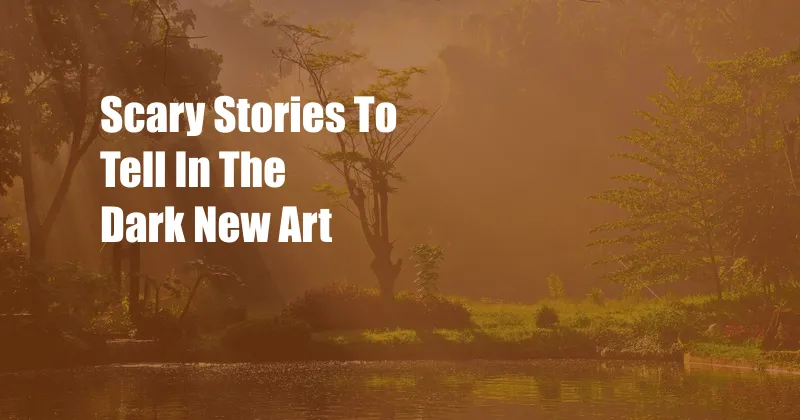
Scary Stories to Tell in the Dark: A Timeless Collection of Spine-Tingling Tales
In the realm of literature, there are few collections as synonymous with childhood fear and fascination as Alvin Schwartz’s “Scary Stories to Tell in the Dark.” Since its initial publication in 1981, this anthology has captivated generations of readers, becoming a staple of slumber parties and campfire nights.
With its chilling illustrations by Stephen Gammell, “Scary Stories to Tell in the Dark” taps into the primal fears that lurk in the depths of our imaginations, leaving an indelible mark on the minds of its readers. But beyond the simple thrills and scares, the stories in this collection offer a deeper exploration of our collective nightmares and the enduring power of storytelling.
The Art of Darkness: Visualizing the Unseen
Stephen Gammell’s haunting illustrations are an integral part of the “Scary Stories to Tell in the Dark” experience. His stark black-and-white drawings perfectly capture the eerie atmosphere of the stories, etching themselves into the memories of readers. Gammell’s art evokes a sense of dread and foreboding, making the invisible terrors of the night seem all too real.
Gammell’s style is characterized by its simplicity and ambiguity. His figures are often skeletal, their expressions hidden or distorted. This creates a sense of mystery and unease, leaving readers to fill in the blanks with their own imaginations. The result is an unsettling and immersive experience that stays with readers long after the final page has been turned.
Definition and History
Scary stories, a subgenre of horror, are tales designed to evoke feelings of fear, suspense, and unease. They often draw upon themes of the supernatural, the unexplained, and the monstrous. Scary stories have been a part of human culture for centuries, taking various forms from oral traditions to written works.
The history of scary stories can be traced back to ancient times, where they served both as a form of entertainment and a way to caution against danger. In the oral tradition, scary stories were passed down from generation to generation, evolving and adapting to different cultural contexts. The written form of scary stories emerged later, with notable works like Edgar Allan Poe’s “The Tell-Tale Heart” and H.P. Lovecraft’s “The Call of Cthulhu” becoming classics of the genre.
The Enduring Appeal of “Scary Stories to Tell in the Dark”
The enduring appeal of “Scary Stories to Tell in the Dark” can be attributed to several factors. First, the stories are simply well-crafted, featuring effective pacing, suspenseful build-ups, and unexpected twists and turns. They draw upon universal fears and anxieties, resonating with readers of all ages.
Second, the anthology format allows readers to dip in and out, sampling different stories and moods. This episodic nature adds to the replayability of the collection, making it a perfect companion for both solitary reading and group storytelling.
Tips and Expert Advice for Telling Scary Stories
If you’re looking to captivate an audience with your own scary stories, there are a few tips and pieces of expert advice to keep in mind:
- Build Suspense: Don’t rush into the scary parts. Instead, gradually build suspense by creating a sense of unease and anticipation. Foreshadowing and subtle hints can effectively create a build-up of tension.
- Control the Atmosphere: The setting and atmosphere of a scary story are crucial. Use vivid descriptions and sensory details to create a sense of place and evoke the mood you want to convey. Lighting, sounds, and smells can all be used to enhance the atmosphere.
- Use Sensory Details: Appeal to the senses of your listeners or readers by incorporating vivid descriptions that engage their sight, sound, smell, taste, and touch. This will help them feel more immersed in the story and experience the fear and suspense more deeply.
- Less is More: Sometimes, the scariest things are left to the imagination. Don’t overdescribe the horrifying elements of your story. Instead, let your audience’s imaginations fill in the gaps, creating a more intense and personalized experience of fear.
- Practice: The more you tell scary stories, the better you will become at it. Practice your delivery, voice modulation, and gestures to enhance the impact of your storytelling.
FAQ on “Scary Stories to Tell in the Dark”
Q: Is “Scary Stories to Tell in the Dark” appropriate for children?
A: While the stories in the collection can be scary, they are generally suitable for children ages 8 and up. Parental discretion is advised, as some stories may be too intense for younger readers.
Q: Are the stories in “Scary Stories to Tell in the Dark” true?
A: No, the stories in the collection are works of fiction created by Alvin Schwartz. However, they are inspired by folklore and urban legends from various cultures.
Q: What is the scariest story in “Scary Stories to Tell in the Dark”?
A: The scariest story in the collection is a matter of personal opinion, but some of the most popular and chilling stories include “The Red Spot,” “Harold,” and “The Ghost with the Bloody Fingers.
Conclusion
Alvin Schwartz’s “Scary Stories to Tell in the Dark” remains a timeless masterpiece of horror literature, its chilling tales and haunting illustrations continuing to captivate readers of all ages. Whether you’re a seasoned storyteller or a curious young reader, this collection is sure to leave a lasting impression on your psyche. So, gather your friends, dim the lights, and prepare to be scared.
Are you interested in learning more about the art of storytelling or exploring other collections of scary stories?